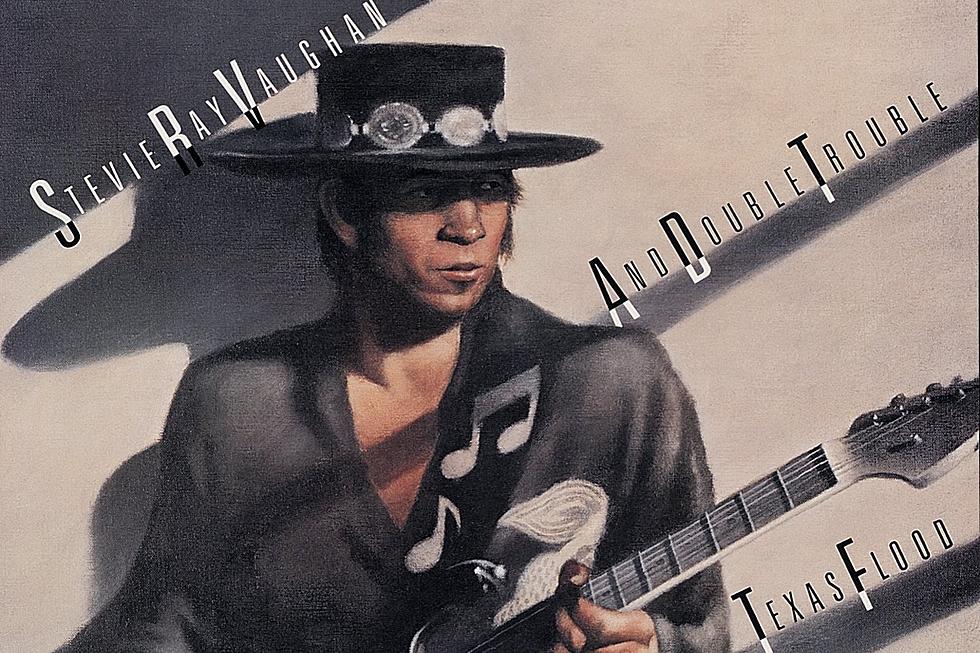
How Stevie Ray Vaughan Sparked a Blues Revolution With ‘Texas Flood’
Stevie Ray Vaughan and Double Trouble recorded their celebrated debut Texas Flood in just three days – or so goes the legend. There's actually far more to it.
The album, which arrived on June 13, 1983, was actually completed in just two days. They spent the first day setting up the equipment – but not because they thought they were about to record what became a double-platinum, genre-reviving blues classic.
"We were just making tape," drummer Chris Layton told Guitar World in 2008. "We hoped that maybe we were making a demo that would actually be listened to by a real record company."
They'd gotten to this point just as quickly, following a breakout performance in the summer of 1982 at the Montreux Jazz Festival. There, they caught the eye of David Bowie (who would garner a splash of new attention for Vaughan by including him as a sideman on 1983's Let's Dance) and Jackson Browne, who offered Double Trouble free use of his Los Angeles recording studio.
The group arrived just before Thanksgiving, recording what they thought were rough sketches for legendary producer John Hammond. "It really was just a big warehouse with concrete floors and some rugs thrown down," bassist Tommy Shannon told Guitar World. "We just found a little corner, set up in a circle looking at and listening to each other, and played like a live band."
They finished two songs on the second day with engineer Richard Mullen, and then eight on the third day. Vaughan wrote or co-wrote six of those 10 tracks, including the Top 20 Billboard rock-chart hit "Pride and Joy," and the remarkably inventive instrumentals "Rude Mood" and "Lenny." Choice covers like Howlin' Wolf's "Tell Me," the Isleys' "Testify" and Buddy Guy's "Mary Had a Little Lamb" rounded things out.
Already, Hammond was certain he was on to something. "Stevie's got a fantastic technique and has natural taste," he told Rolling Stone in 1983. "That's a very difficult thing to find. He's brought back a style that had died, and he brought it back at exactly the right time. The young ears haven't heard anything with this kind of sound."
Listen to Stevie Ray Vaughan's 'Pride and Joy'
Before they knew it, Epic Records A&R man Greg Geller signed Double Trouble; the tapes were then released as-is under the title Texas Flood, after a Jimi Hendrix-esque update of a tune by Larry Davis.
Vaughan didn't shy away from the comparison, though there was more to his sound, which was built off a sturdy foundation of electric blues by the likes of Albert King, Otis Rush and Muddy Waters. There was also some Django Reinhardt in there, and some Lonnie Mack too. Then something that was entirely his own.
"I'm not really trying to sound like Hendrix," Vaughan cautioned in a 1984 talk with Guitar Interactive. "But I'm not going to avoid what I do understand about how he played. It's valid, and one of the first times in a long time when rock music was played with soul. That was the whole thing with him. He put so much soul into it; he made it come back to being real again, instead of just a commercial thing."
There are few better summations of what happened that long weekend at Browne's Down Town Studio. Everything about it was determinedly, blessedly "real," right down to the title track – which Double Trouble cut last, burning through one take as their allotment of studio time expired.
"That song and the whole first album captures the pure essence of what Stevie was all about," Layton told Guitar World. "Countless people would tell Stevie how much they loved his guitar tone on Texas Flood. There was literally nothing between the guitar and the amp. The real tone just came from Stevie, and that whole recording was just so pure; the whole experience couldn't have been more innocent or naive."
Texas Flood rose to the Billboard Top 40, a remarkable achievement for a blues album – and for a musician who'd grown up in the considerable shadow of his older guitar-playing brother Jimmie of the Fabulous Thunderbirds. This album moved Stevie to another level.
"Jimmie showed me a lot of stuff," the younger Vaughan said back in 1983. "There was a time when he warned, 'If you ask me to show you anything again, I'll kick your ass.' Well, I did and he did!"
Watch Stevie Ray Vaughan Perform 'Texas Flood'
He kept learning, soaking up ideas and history like a sponge. By 17, Vaughan had left school to concentrate on music full time. Eventually, he fell in with the other members of Double Trouble, a name Stevie swiped from an old Otis Rush song. At first, Lou Ann Barton fronted the group, but Vaughan ultimately moved up when she departed.
Layton never forgot the first time he heard Vaughan play, outside the Soap Creek Saloon in Austin. "Drove up, got out of my car," he told In the Studio With Redbeard, "and I heard this piercing guitar. It was just like drilling right there in the walls of the building. I thought, 'Wow, who is this guy?' And, it was Stevie. I thought, 'He's remarkable.'"
Montreux beckoned. There, David Bowie heard it too, and Jackson Browne heard it, then John Hammond heard it – and then we all did. Fans weren't the only ones marveling over Double Trouble's meteoric triumph, secured over a matter of hours in an L.A. studio.
"We were just playing," Layton told Guitar World. "If we'd had known what was going to happen with it all, we might have screwed up. The magic was there and it came through on the tape. You can get most of what the band was ever about right there."
Vaughan never toured with Bowie in support of Let's Dance, but that actually ended up helping rather than hurting.
The problem: Bowie was hitting the road in May 1983, just as Double Trouble's debut was set to arrive on store shelves. The dates would have kept Vaughan away for a year, while whatever momentum generated by album sales for Texas Flood dissipated. Negotiations commenced, and they eventually reached an agreement in which Double Trouble would open select dates for Bowie.
Unfortunately, Vaughan later grumbled, that promise "was just a lotta bullshit." Bowie's management apparently reneged, denying Double Trouble the opening gig while also stipulating that Vaughan couldn't give interviews about Texas Flood while appearing with Bowie.
Chesley Millikin, Vaughan's manager, reportedly showed up moments before Vaughan was set to leave, pulling the guitarist's luggage and gear off of the tour bus. Bowie left him there on the sidewalk. An incredibly bright future lay just ahead, but it was one Stevie Ray Vaughan could not yet see.
Top 25 Southern Rock Albums
More From Ultimate Classic Rock









